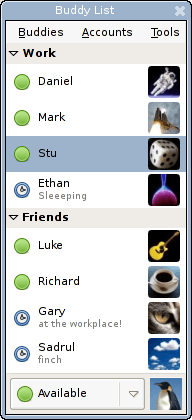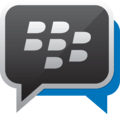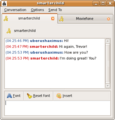Instant messaging facts for kids

Instant messaging (IM) is a way of chatting between two or more people by typing text. The text is then sent by computers over a network such as the Internet.
Instant messaging must have an instant messaging client that hooks up to a service that can send instant messages. Instant messaging is different from e-mail because conversations happen and can be read right away (instantly). A multiprotocol instant messaging application lets one connect to many IM networks. Instant messaging services got many ideas from an older and still popular way to online chat named Internet Relay Chat (IRC).
Contents
Benefits
Instant messaging offers real-time communication and allows easy collaboration, which might be considered more akin to genuine conversation than email's "letter" format. In contrast to e-mail, the parties know whether the peer is available. Most systems allow the user to set an online status or away message so peers are notified when the user is available, busy, or away from the computer. On the other hand, people are not forced to reply immediately to incoming messages. For this reason, some people consider communication via instant messaging to be less intrusive than communication via phone.
Instant messaging allows instantaneous communication between a number of parties simultaneously, by transmitting information quickly and efficiently, featuring immediate receipt of acknowledgment or reply. In certain cases IM involves additional features, which make it even more popular, i.e. to see the other party, e.g. by using ((web-cams)), or to talk directly for free over the internet.
History
Instant messaging applications began to appear in the 1970s on multi-user operating systems like UNIX, initially to facilitate communication with other users logged in to the same machine, then on the local network, and subsequently across the Internet. Modern, Internet-wide, GUI-based messaging clients, as they are known today, began to take off in the mid 1990s with ICQ (1996) being the first, followed by AOL Instant Messenger (AOL Instant Messenger, 1997). Meanwhile, other companies developed their own applications (Yahoo, MSN, Excite, Ubique, IBM).
User base
More than 100 million users
| Instant messenger client | Company | Usage |
|---|---|---|
| Discord | Discord Inc. | 250 million users (May 2019) |
| eBuddy XMS | eBuddy | 250 million users (September 2011) |
| Facebook Messenger | Facebook, Inc. | 900 million active users (April 2016), 1.3 billion monthly active users (September 2017) |
| iMessage | Apple Inc. | 140 million users (June 2012) |
| JioChat | Jio Platforms | 53 million users (June 2020) |
| Kik Messenger | Kik Interactive | 300 million users (May 2016) |
| Line | Naver Corporation | 217 million monthly active users (2016) |
| Skype | Microsoft Corporation | 300 million monthly active users (5 June 2019), 1.55 billion registered users (2019), 4.9 million daily active users (2 March 2014), 34 million peak online (February 2012). |
| Snapchat | Snap Inc. | 301 million monthly active users (2016) |
| Telegram | Telegram Messenger LLP | 400 million monthly active users (April 2020) |
| Tencent QQ | Tencent Holdings Limited | 823 million monthly active users (July 2019) |
| Viber | Rakuten | 260 million monthly active users (January 2019), 1.169 billion registered users (March 2020) |
| Tencent Holdings Limited | 1132.7 million monthly active users (Q2 '2019) | |
| Facebook, Inc. | 1200 million monthly active users (January 2017), 2 billion registered users (12 February 2020), 500 million daily active users (March 2019). | |
| ShareChat | Mohalla Tech Private Limited | 60 million monthly active users (January 2019) |
Related pages
Images for kids
-
A buddy list on Pidgin
-
Command-line Unix "talk", using a split screen user interface, was popular in the 1980s and early 1990s.
-
Facebook Chat, example of IM through a wider social network that became popular in the late 2000s
See also
 In Spanish: Mensajería instantánea para niños
In Spanish: Mensajería instantánea para niños








